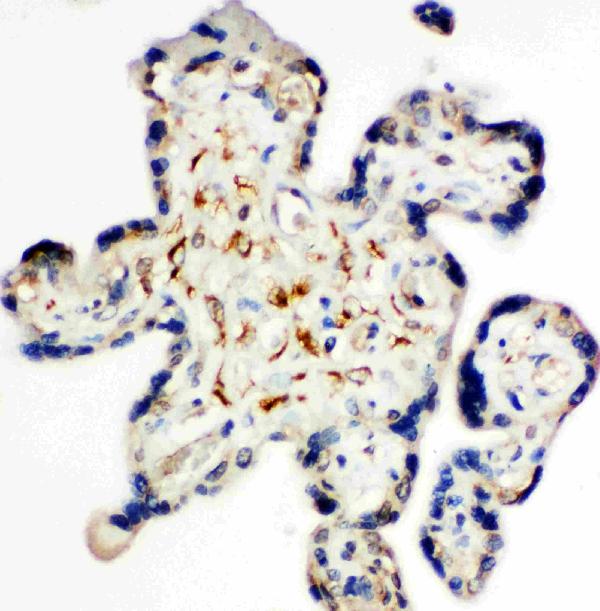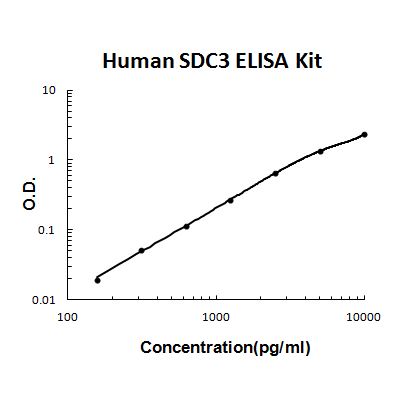Product Info Summary
| SKU: | PA2133 |
|---|---|
| Size: | 100 μg/vial |
| Reactive Species: | Human, Mouse, Rat |
| Host: | Rabbit |
| Application: | IHC, WB |
Customers Who Bought This Also Bought
Product info
Product Name
Anti-Syndecan 3/SDC3 Antibody Picoband®
SKU/Catalog Number
PA2133
Size
100 μg/vial
Form
Lyophilized
Description
Boster Bio Anti-Syndecan 3/SDC3 Antibody catalog # PA2133. Tested in IHC, WB applications. This antibody reacts with Human, Mouse, Rat. The brand Picoband indicates this is a premium antibody that guarantees superior quality, high affinity, and strong signals with minimal background in Western blot applications. Only our best-performing antibodies are designated as Picoband, ensuring unmatched performance.
Storage & Handling
Store at -20˚C for one year from date of receipt. After reconstitution, at 4˚C for one month. It can also be aliquotted and stored frozen at -20˚C for six months. Avoid repeated freeze-thaw cycles.
Cite This Product
Anti-Syndecan 3/SDC3 Antibody Picoband® (Boster Biological Technology, Pleasanton CA, USA, Catalog # PA2133)
Host
Rabbit
Contents
Each vial contains 5mg BSA, 0.9mg NaCl, 0.2mg Na2HPO4, 0.05mg Thimerosal, 0.05mg NaN3.
Clonality
Polyclonal
Isotype
Rabbit IgG
Immunogen
A synthetic peptide corresponding to a sequence at the N-terminus of mouse Syndecan 3/SDC3, identical to the related rat sequence, and different from the related human sequence by one amino acid.
*Blocking peptide can be purchased. Costs vary based on immunogen length. Contact us for pricing.
Cross-reactivity
No cross-reactivity with other proteins
Reactive Species
PA2133 is reactive to Sdc3 in Human, Mouse, Rat
Reconstitution
Add 0.2ml of distilled water will yield a concentration of 500ug/ml.
Observed Molecular Weight
60 kDa
Calculated molecular weight
46002 MW
Background of SDC3
Syndecan-3, also called SYND3 is a protein that in humans is encoded by the SDC3 gene. This gene was assigned to human chromosome 1p35.2. This gene can function as in trans HIV receptors via binding of HIV-1 gp120 to the syndecan heparin sulfate chains. It may play a role in the organization of cell shape by affecting the actin cytoskeleton, and possibly by transferring signals from the cell surface in a sugar-dependent mechanism. In wildtype mice, SDC3 was expressed in hypothalamic regions that control energy balance. It was proposed that oscillation of hypothalamic SDC3 levels physiologically modulates feeding behavior.
Antibody Validation
Boster validates all antibodies on WB, IHC, ICC, Immunofluorescence, and ELISA with known positive control and negative samples to ensure specificity and high affinity, including thorough antibody incubations.
Application & Images
Applications
PA2133 is guaranteed for IHC, WB Boster Guarantee
Assay Dilutions Recommendation
The recommendations below provide a starting point for assay optimization. The actual working concentration varies and should be decided by the user.
Immunohistochemistry (Paraffin-embedded Section), 0.5-1μg/ml, Human, Rat, Mouse, By Heat
Western blot, 0.1-0.5μg/ml, Human, Mouse, Rat
Positive Control
WB: human U20S whole cell, rat PC-12 whole cell, mouse NIH/3T3 whole cell
IHC: Human Placenta tissue, Rat Brain tissue
Validation Images & Assay Conditions

Click image to see more details
Figure 1. IHC analysis of Syndecan 3/SDC3 using anti-Syndecan 3/SDC3 antibody (PA2133).
Syndecan 3/SDC3 was detected in a paraffin-embedded section of Human Placenta tissue. Heat mediated antigen retrieval was performed in EDTA buffer (pH 8.0, epitope retrieval solution). The tissue section was blocked with 10% goat serum. The tissue section was then incubated with 1 μg/ml rabbit anti-Syndecan 3/SDC3 Antibody (PA2133) overnight at 4°C. Biotinylated goat anti-rabbit IgG was used as secondary antibody and incubated for 30 minutes at 37°C. The tissue section was developed using Strepavidin-Biotin-Complex (SABC) (Catalog # SA1022) with DAB as the chromogen.

Click image to see more details
Figure 2. IHC analysis of Syndecan 3/SDC3 using anti-Syndecan 3/SDC3 antibody (PA2133).
Syndecan 3/SDC3 was detected in a paraffin-embedded section of Rat Brain tissue. Heat mediated antigen retrieval was performed in EDTA buffer (pH 8.0, epitope retrieval solution). The tissue section was blocked with 10% goat serum. The tissue section was then incubated with 1 μg/ml rabbit anti-Syndecan 3/SDC3 Antibody (PA2133) overnight at 4°C. Biotinylated goat anti-rabbit IgG was used as secondary antibody and incubated for 30 minutes at 37°C. The tissue section was developed using Strepavidin-Biotin-Complex (SABC) (Catalog # SA1022) with DAB as the chromogen.

Click image to see more details
Figure 3. Western blot analysis of Syndecan 3/SDC3 using anti-Syndecan 3/SDC3 antibody (PA2133).
Electrophoresis was performed on a 5-20% SDS-PAGE gel at 70V (Stacking gel) / 90V (Resolving gel) for 2-3 hours. The sample well of each lane was loaded with 30 ug of sample under reducing conditions.
Lane 1: human U20S whole cell lysates,
Lane 2: rat PC-12 whole cell lysates,
Lane 3: mouse NIH/3T3 whole cell lysates.
After electrophoresis, proteins were transferred to a nitrocellulose membrane at 150 mA for 50-90 minutes. Blocked the membrane with 5% non-fat milk/TBS for 1.5 hour at RT. The membrane was incubated with rabbit anti-Syndecan 3/SDC3 antigen affinity purified polyclonal antibody (Catalog # PA2133) at 0.5 μg/mL overnight at 4°C, then washed with TBS-0.1%Tween 3 times with 5 minutes each and probed with a goat anti-rabbit IgG-HRP secondary antibody at a dilution of 1:5000 for 1.5 hour at RT. The signal is developed using an Enhanced Chemiluminescent detection (ECL) kit (Catalog # EK1002) with Tanon 5200 system. A specific band was detected for Syndecan 3/SDC3 at approximately 60 kDa. The expected band size for Syndecan 3/SDC3 is at 45 kDa.
Protein Target Info & Infographic
Gene/Protein Information For Sdc3 (Source: Uniprot.org, NCBI)
Gene Name
Sdc3
Full Name
Syndecan-3
Weight
46002 MW
Superfamily
syndecan proteoglycan family
Alternative Names
Syndecan-3;SYND3;Sdc3;Kiaa0468; SDC3 SDCN, SYND3 syndecan 3 syndecan-3|N-syndecan|syndecan neural type|syndecan proteoglycan 3
*If product is indicated to react with multiple species, protein info is based on the gene entry specified above in "Species".For more info on Sdc3, check out the Sdc3 Infographic

We have 30,000+ of these available, one for each gene! Check them out.
In this infographic, you will see the following information for Sdc3: database IDs, superfamily, protein function, synonyms, molecular weight, chromosomal locations, tissues of expression, subcellular locations, post-translational modifications, and related diseases, research areas & pathways. If you want to see more information included, or would like to contribute to it and be acknowledged, please contact [email protected].
Specific Publications For Anti-Syndecan 3/SDC3 Antibody Picoband® (PA2133)
Hello CJ!
PA2133 has been cited in 2 publications:
*The publications in this section are manually curated by our staff scientists. They may differ from Bioz's machine gathered results. Both are accurate. If you find a publication citing this product but is missing from this list, please let us know we will issue you a thank-you coupon.
Yao, J., Zhang, L.L., Huang, X.M., Li, W.Y., & Gao, S.G. (2017). Pleiotrophin and N-syndecan promote perineural invasion and tumor progression in an orthotopic mouse model of pancreatic cancer. World Journal of Gastroenterology, 23(21), 3907-3914....
Yao J, Li Wy, Li Sg, Feng Xs, Gao Sg. World J Gastroenterol. 2014 Mar 21;20(11):3018-24. Doi: 10.3748/Wjg.V20.I11.3018. Midkine Promotes Perineural Invasion In Human Pancreatic Cancer.
Recommended Resources
Here are featured tools and databases that you might find useful.
- Boster's Pathways Library
- Protein Databases
- Bioscience Research Protocol Resources
- Data Processing & Analysis Software
- Photo Editing Software
- Scientific Literature Resources
- Research Paper Management Tools
- Molecular Biology Software
- Primer Design Tools
- Bioinformatics Tools
- Phylogenetic Tree Analysis
Customer Reviews
Have you used Anti-Syndecan 3/SDC3 Antibody Picoband®?
Submit a review and receive an Amazon gift card.
- $30 for a review with an image
0 Reviews For Anti-Syndecan 3/SDC3 Antibody Picoband®
Customer Q&As
Have a question?
Find answers in Q&As, reviews.
Can't find your answer?
Submit your question
7 Customer Q&As for Anti-Syndecan 3/SDC3 Antibody Picoband®
Question
Can you please confirm antigen retrieval technique that was used when testing PA2133 for IHC?
Verified customer
Asked: 2022-05-13
Answer
Please see the following suggested Antigen Retrieval instruction for Anti-Syndecan 3/SDC3 Antibody (PA2133): Heat-induced epitope retrieval: Immerse the slides in antigen retrieval buffer (EDTA buffer, pH 8.0). Microwave the solution at Medium-high power for 8 minutes. Cool the slides for 5 minutes. Then microwave the solution at High power for 4 minutes. Cool the slides to room temperature.
Boster Scientific Support
Answered: 2022-05-16
Question
Please see the WB image, lot number and protocol we used for brain using anti-Syndecan 3/SDC3 antibody PA2133. Please let me know if you require anything else.
Verified Customer
Verified customer
Asked: 2019-12-24
Answer
Thank you very much for the data. Our lab team are working to resolve this as quickly as possible, and we appreciate your patience and understanding! You have provided everything we needed. Please let me know if there is anything you need in the meantime.
Boster Scientific Support
Answered: 2019-12-24
Question
I was wanting to use your anti-Syndecan 3/SDC3 antibody for IHC for human brain on frozen tissues, but I want to know if it has been tested for this particular application. Has this antibody been tested and is this antibody a good choice for human brain identification?
Verified Customer
Verified customer
Asked: 2019-10-16
Answer
You can see on the product datasheet, PA2133 anti-Syndecan 3/SDC3 antibody has been tested for IHC, WB on human, mouse, rat tissues. We have an innovator award program that if you test this antibody and show it works in human brain in IHC-frozen, you can get your next antibody for free.
Boster Scientific Support
Answered: 2019-10-16
Question
We are currently using anti-Syndecan 3/SDC3 antibody PA2133 for mouse tissue, and we are happy with the IHC results. The species of reactivity given in the datasheet says human, mouse, rat. Is it likely that the antibody can work on feline tissues as well?
Verified Customer
Verified customer
Asked: 2019-08-22
Answer
The anti-Syndecan 3/SDC3 antibody (PA2133) has not been tested for cross reactivity specifically with feline tissues, though there is a good chance of cross reactivity. We have an innovator award program that if you test this antibody and show it works in feline you can get your next antibody for free. Please contact me if I can help you with anything.
Boster Scientific Support
Answered: 2019-08-22
Question
Is a blocking peptide available for product anti-Syndecan 3/SDC3 antibody (PA2133)?
Verified Customer
Verified customer
Asked: 2018-11-02
Answer
We do provide the blocking peptide for product anti-Syndecan 3/SDC3 antibody (PA2133). If you would like to place an order for it please contact [email protected] and make a special request.
Boster Scientific Support
Answered: 2018-11-02
Question
I appreciate helping with my inquiry over the phone. Here are the WB image, lot number and protocol we used for brain using anti-Syndecan 3/SDC3 antibody PA2133. Let me know if you need anything else.
B. Collins
Verified customer
Asked: 2018-10-09
Answer
Thanks for the data. You have provided everything we needed. Our lab team are working to resolve your inquiry as quickly as possible, and we appreciate your patience and understanding! Please let me know if there is anything you need in the meantime.
Boster Scientific Support
Answered: 2018-10-09
Question
Is this PA2133 anti-Syndecan 3/SDC3 antibody reactive to the isotypes of SDC3?
Verified Customer
Verified customer
Asked: 2017-07-14
Answer
The immunogen of PA2133 anti-Syndecan 3/SDC3 antibody is A synthetic peptide corresponding to a sequence at the N-terminus of mouse Syndecan 3/SDC3 (45-60aa AQRWRNENFERPVDLE), identical to the related rat sequence, and different from the related human sequence by one amino acid. Could you tell me which isotype you are interested in so I can help see if the immunogen is part of this isotype?
Boster Scientific Support
Answered: 2017-07-14





